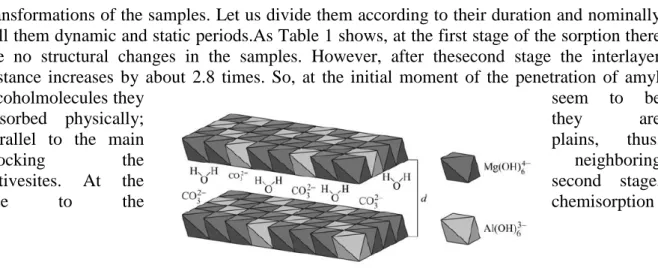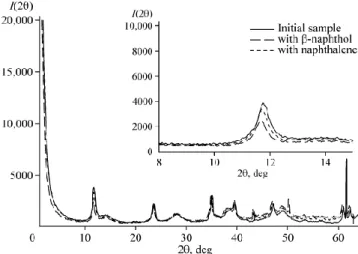HAL Id: insu-00730921
https://hal-insu.archives-ouvertes.fr/insu-00730921
Submitted on 22 Nov 2012HAL is a multi-disciplinary open access archive for the deposit and dissemination of sci-entific research documents, whether they are pub-lished or not. The documents may come from teaching and research institutions in France or abroad, or from public or private research centers.
L’archive ouverte pluridisciplinaire HAL, est destinée au dépôt et à la diffusion de documents scientifiques de niveau recherche, publiés ou non, émanant des établissements d’enseignement et de recherche français ou étrangers, des laboratoires publics ou privés.
Changes in the structure of MgxAly(OH)z layered
double hydroxides during the adsorption of organic
compounds
E.O Butenko, E.V. Kapustina, A.E. Kapustin, V.S. Kracvenko, S.A.
Gromilov, Régis Guégan
To cite this version:
E.O Butenko, E.V. Kapustina, A.E. Kapustin, V.S. Kracvenko, S.A. Gromilov, et al.. Changes in the structure of MgxAly(OH)z layered double hydroxides during the adsorption of organic com-pounds. Journal of Structural Chemistry, Springer Verlag (Germany), 2011, 52 (2), pp.436-438. �10.1134/S0022476611020284�. �insu-00730921�
CHANGES IN THE STRUCTURE OF MgxAly(OH)zLAYERED DOUBLE
HYDROXIDES DURING THE ADSORPTION OF ORGANIC COMPOUNDS
É. O. Butenko1, E. V. Kapustina1, A. E. Kapustin1,V. S. Kravchenko2, S. A. Gromilov2, and R. Guegan3
1
Azov State Technical University, Mariupol, Ukraine. 2
A. V. Nikolaev Institute of Inorganic Chemistry, Siberian Division, Russian Academy of Sciences, Novosibirsk; grom@niic.nsc.ru.
3
Institut des Sciences de la Terre d’Orleans, France (Orleans Institute of Earth Sciences, France)
Changes in the structure of synthetic MgxAly(OH)z layered double hydroxides are studied
during thesorption of organic compounds.
Keywords: MgxAly(OH)zlayered double hydroxides, polycrystal X-ray diffraction, specific
surface area.
Layered double hydroxides (LDHs) are used as sorbents, catalysts, and carriers for catalytic species. In general, theyare natural or synthetic minerals with part of their cations being replaced isomorphically with cations of higher oxidationstates, which results in the formation of positively charged two-dimensional layers containing solvate molecules andcounterions capable of anion exchange [1]. LDHs are solid bases [2]. Since there are both Bronsted and Lewis sites, anionexchange processes occur in the interlayer internal space of LDHs [3]. The interlayer distance depends on the nature ofanions and solvate molecules as well as the degree of isomorphic substitution. When the interlayer distance changes, LDHproperties also change (for example, sorption capacity changes because of the changing number of available active sites). Astudy of the LDH structure and its changes during the sorption of various compounds provides conclusions about themechanism of these processes and prospects of creating new materials with desired properties.This work reveals regular changes in the structure of synthetic MgxAly(OH)zhydrotalcites of various composition,which occur during the
adsorption of amyl alcohol, naphthalene, and β-naphthol. The hydrotalcite structure is shown in Fig. 1.
Experimental.
MgxAly (OH)z samples were prepared according to the procedures described in [4, 5].X-ray diffraction was performed on Siemens D-500 (СоKα1 radiation, λ = 1.789 Å) and
DRON-UM1diffractometers (СuKαradiation, Ni filter).The specific surface area of the samples was
determined from the low-temperature nitrogen adsorptionmeasurements followed by the processing of the obtained data using the BET method.
Results and Discussion.
A study of the sorption of С5Н11ОН amyl alcohol on MgxAly(OH)zsamples has shown thatthe
sorption process consists of two stages. At the beginning, apparent dynamic equilibrium is established rapidly (in tens ofminutes). However, on long keeping (48 h) the degree of sorption increases significantly, and, what is more important, it isaccompanied by structural
transformations of the samples. Let us divide them according to their duration and nominally call them dynamic and static periods.As Table 1 shows, at the first stage of the sorption there are no structural changes in the samples. However, after thesecond stage the interlayer distance increases by about 2.8 times. So, at the initial moment of the penetration of amyl alcoholmolecules they seem to be adsorbed physically; they are parallel to the main plains, thus,
blocking the neighboring
activesites. At the second stage,
due to the chemisorption
Fig. 1. Layered structure of MgxAly(OH)zhydrotalcite. Water and CO32−molecules are inside the interlayerspace.
TABLE 1. Sorption Capacities (C) and Interlayer Distances (d) in MgxAly(OH)z During the Sorption of Amyl
Alcohol in Dynamicand StaticPeriods
TABLE 2.MgxAly(OH)z Specific Surface Area
(ionic exchange processes) the intercalated molecules are reoriented, andthey expand the hydrotalcite inner space. This property is typical of many organic compounds, and the extent of changes inthe LDH interlayer distance depends on the length of the hydrocarbon radical, its configuration, and orientation in theinterplanar space [6].
In order to study the effect of the structure and size of the adsorbed molecules on the structural characteristics ofLDHs, aromatic compounds were used: С10Н8naphthalene and
С10Н7ОН β -naphthol. The main difference between them is the nature of the sorption.
Physical adsorption is typical of naphthalene, while in the case of β-naphthol, the sorption causesthe anion exchange reaction due to its active hydroxyl group. In the first case, the activity and selectivity of the sorption isdetermined by the sorbent specific surface area and
pore sizes, while in the second case, by the concentration of active siteson the sorbent surface and their accessibility to the substrate molecules.
Fig. 2 shows typical X-ray patterns of starting hydrotalcite and the samples with sorbed naphthalene and β-naphthol.If we compare these X-ray patterns, it is evident that when both naphthalene and β-naphthol are sorbed, thehydrotalcite structural parameters change, as it could be seen in the highlighted inset. For β-naphthol there are larger changesin the structural parameters, which is not surprising because of its possible chemisorption. Changes that are caused by thephysical adsorption of naphthalene are likely to be attributed to a large size of its molecules.
Fig. 2. Typical X-ray patterns of hydrotalcitesamples.
Along with the changes in the crystal structure parameters during the sorption of naphthalene and β-naphthol, thereare also changes in the microstructure of the samples. Namely, their specific surface area change. As Table 2 shows, thoughthis value has a non-monotonic dependence on the composition, it generally increases as aluminum isomorphically substitutesfor magnesium. On the contrary, after the sorption of naphthalene and β-naphthol the most evident relative changes in theMgxAly(OH)zspecific surface areas occur in the
samples with a low concentration of aluminum.
Conclusions.
It is shown that there is a difference in changes in the structure of LDHs during the sorption of organiccompounds with regard to the ionic exchange and physical sorption. Moreover, it is established that the structure of theorganic molecule depends on changes in the size of the interlayer distance in LDHs.
REFERENCES
1. A. Vaccari, Layered Double Hydroxides: Present and Future, Nova Science Publishers Inc., New York (2002)
2. X. Duan and D. G. Evans, Layered Double Hydroхides. Structure аnd Bonding, Heidelberg: Springer-Verlag, Berlin(2006)
3. A. E. Kapustin, Usp. Khim. , 60, No. 12, 2685-2717 (1991).
4. M. Bolongini and C. Perego, Microporous and Mesoporous Materials, 66 , 77 (2003). 5. W. T. Reichle, Solid State Ionics, 22 , 135 (1986).

